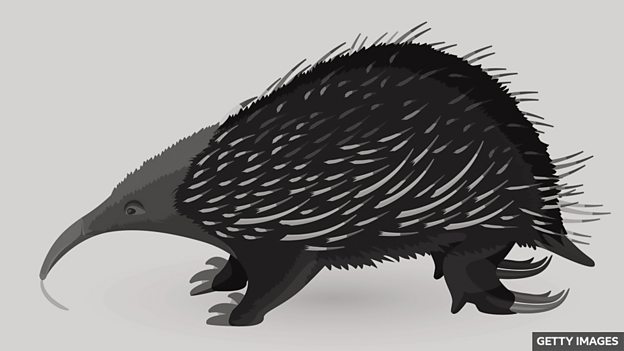科学家们首次拍摄到以戴维·阿滕伯勒爵士的名字命名的一种古老的卵生哺乳动物 —— Attenborough long-beaked echidna 阿滕伯勒长喙针鼹。此前人们认为这种针鼹恐怕已经灭绝,但这些影像证明事实并非如此。
The black-and-white images taken from a camera trap show the Attenborough long-beaked echidna lumbering through the rainforest. Four three-second bursts of video. The first time this species had ever been caught on camera. And proof after years of searching, that they are not extinct and live in the remote Cyclops mountains of Indonesia.
从相机陷阱拍摄的黑白影像中可以看到阿滕伯勒长喙针鼹缓慢笨拙地在雨林中穿行。影像包括四段三秒长的视频。这是该物种首次被相机拍摄到。经过多年的寻找,这些影像证明了阿滕伯勒长喙针鼹并没有灭绝,它们生活在印度尼西亚偏远的独眼巨人山脉。
Echidna have spikes on their back like a porcupine and a toothless beak with which they dig for insects.
针鼹的背上有像豪猪一样的尖刺,没有牙齿的喙用来挖食昆虫。
It's hoped their rediscovery will strengthen the case for the pristine mountains they live in to be further protected.
研究人员希望这个发现充分表明了阿滕伯勒长喙针鼹生活的原始山脉需得到进一步的保护。
词汇表
black-and-white 黑白的
camera trap (用于野外生态研究的)相机陷阱,隐藏的遥控相机
lumbering 缓慢笨拙地移动
caught on camera 被相机拍到
extinct 灭绝的
spikes 尖刺
porcupine 豪猪
beak 喙,(动物的)嘴
pristine 原始的,未受损的
阅读理解:请在读完上文后,回答下列问题。
1. What kind of environment was this echidna filmed in?
2. True or False? Echidna have smooth backs.
3. How do echidna get insects to eat?
4. What do some people hope happens as a result of this discovery?
答案
1. What kind of environment was this echidna filmed in?
This echidna was filmed in a rainforest.
2. True or False? Echidna have smooth backs.
False. Echidna have spikes on their back, like a porcupine.
3. How do echidna get insects to eat?
They use a toothless beak to dig for insects.
4. What do some people hope happens as a result of this discovery?
People hope the rediscovery of the Attenborough long-beaked echidna will strengthen the case for the pristine mountains they live in to be further protected.



